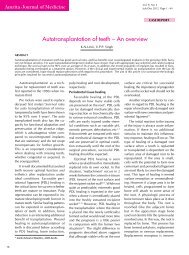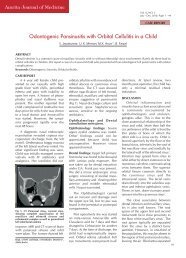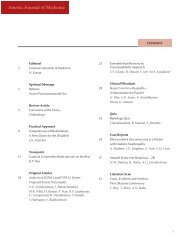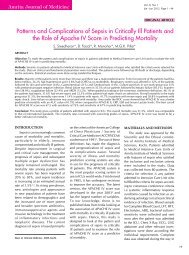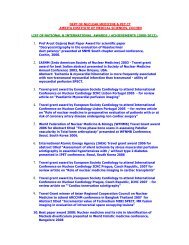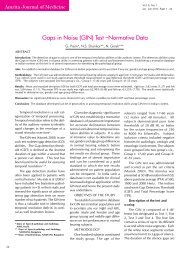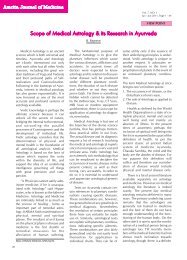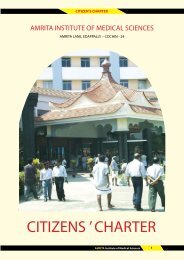Journal of Medicine Vol 2 - Amrita Institute of Medical Sciences and ...
Journal of Medicine Vol 2 - Amrita Institute of Medical Sciences and ...
Journal of Medicine Vol 2 - Amrita Institute of Medical Sciences and ...
You also want an ePaper? Increase the reach of your titles
YUMPU automatically turns print PDFs into web optimized ePapers that Google loves.
<strong>Amrita</strong> <strong>Journal</strong> <strong>of</strong> <strong>Medicine</strong><br />
CASE REPORT<br />
Transfusion-related Acute Lung Injury:<br />
A Case Report <strong>and</strong> Review <strong>of</strong> Recent Advances<br />
S. Sharma, A.Gauhar, D.K. VijayKumar, J. Paul*<br />
ABSTRACT<br />
Transfusion-related acute lung injury (TRALI) is an emerging as a common cause <strong>of</strong> transfusion related adverse events. However the awareness<br />
about this entity in medical fraternity is low <strong>and</strong> consequently it is an under diagnosed <strong>and</strong> very underreported complication <strong>of</strong> transfusion<br />
therapy. We report a case <strong>of</strong> 46-year old lady who developed acute hemodynamic <strong>and</strong> respiratory instability following a single unit blood<br />
transfusion in the postoperative period. She responded to symptomatic management with vasopressor <strong>and</strong> ventilator support. The diagnosis <strong>of</strong><br />
TRALI relies on excluding other diagnoses such as sepsis, volume overload, <strong>and</strong> cardiogenic pulmonary edema. All plasma-containing blood<br />
products have been implicated in TRALI, with the majority <strong>of</strong> cases linked to whole blood, packed RBCs, platelets, <strong>and</strong> fresh-frozen plasma.<br />
The pathogenesis <strong>of</strong> TRALI may be explained by a “two-hit” hypothesis, involving priming <strong>of</strong> the inflammatory machinery <strong>and</strong> then activation<br />
<strong>of</strong> this primed mechanism. Treatment is supportive, with a prognosis substantially better than most causes <strong>of</strong> clinical acute lung injury.<br />
KEY WORDS: Transfusion-related; acute lung injury, blood transfusion, acute respiratory distress syndrome; non-cardiogenic pulmonary<br />
edema.<br />
KEY MESSAGES: The article is written with an intention to spread awareness among the medical fraternity to this <strong>of</strong>ten missed, misdiagnosed<br />
entity that is more frequent than we would like ourselves to believe.<br />
36<br />
INTRODUCTION<br />
Transfusion related acute lung injury<br />
(TRALI) is a frequently<br />
misdiagnosed, yet potentially fatal<br />
reaction following transfusion <strong>of</strong> blood<br />
products. There is a lot <strong>of</strong> confusion<br />
in the literature regarding this entity<br />
because till recently there was no uniform<br />
nomenclature, definition or<br />
diagnostic features described in relation<br />
to it.<br />
We describe a case report <strong>of</strong> TRALI,<br />
not because it is infrequent, unique<br />
or has never been described before,<br />
but to familiarize our colleagues with<br />
it. The intention <strong>of</strong> this article is to<br />
compile available information to selfeducate<br />
ourselves to a potentially<br />
preventable life-threatening condition<br />
<strong>and</strong> the current guidelines for its management.<br />
CASE HISTORY<br />
A 46-year-old lady, who had undergone<br />
surgery for ovarian<br />
Dept. <strong>of</strong> Surgical Oncology, AIMS, Kochi.<br />
* Dept. <strong>of</strong> Anaesthesia, AIMS, Kochi.<br />
malignancy, reported breathlessness on<br />
the first post-operative day. Her complaints<br />
had started within 20-25<br />
minutes <strong>of</strong> completion <strong>of</strong> a transfusion<br />
<strong>of</strong> single unit <strong>of</strong> packed red blood<br />
cells (PRBC). She also had chest discomfort<br />
<strong>and</strong> rapidly progressed to<br />
become unstable haemodynamically<br />
with a falling oxygen saturation<br />
(30/min),<br />
<strong>and</strong> mild fever (100° F). Immediate<br />
investigations done are shown in<br />
Table1.<br />
The patient required ventilatory<br />
support with a positive end expiratory<br />
pressure (PEEP) <strong>of</strong> 10 for 3 days along<br />
with a hemodynamic support with<br />
Dopamine, Dobutamine <strong>and</strong> Noradrenaline<br />
(these could be tapered <strong>and</strong><br />
withdrawn within the next 48 hours).<br />
The initial differential diagnosis<br />
was between a transfusion mismatch,<br />
myocardial infarction, pulmonary<br />
embolism or a fluid overload. Post<br />
transfusion recipient <strong>and</strong> bag blood<br />
sample were sent immediately to the<br />
blood bank where a mismatch was<br />
ruled out. Also patient had no typical<br />
features <strong>of</strong> a cross match reaction like<br />
bronchospasm, rashes, hemoglobinuria,<br />
renal shutdown, or falling<br />
hemoglobin levels, etc. Fluid overload<br />
was ruled out in face <strong>of</strong> a normal CVP<br />
<strong>and</strong> normal ECHO. A normal ECG,<br />
normal ECHO <strong>and</strong> near normal cardiac<br />
enzymes ruled out the possibility<br />
<strong>of</strong> an acute myocardial ischemic<br />
event. Pulmonary embolism was<br />
eliminated from the differential diagnosis<br />
on the basis <strong>of</strong> bilateral extensive<br />
pulmonary infiltrates, normal D-<br />
dimer values <strong>and</strong> no clinical signs <strong>of</strong><br />
deep vein thrombosis.<br />
In this setting a possibility <strong>of</strong><br />
TRALI was raised. Patient’s clinical<br />
features, course <strong>of</strong> events, response <strong>of</strong><br />
the acute episode to supportive management,<br />
all were supportive <strong>of</strong> this<br />
diagnosis.<br />
The patient eventually recovered<br />
from this acute reaction over next 5<br />
days <strong>and</strong> was discharged to home on<br />
the 10 th postoperative day.



